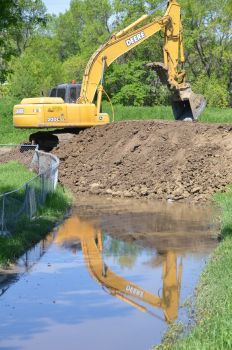Emergency Inspection

|
| FEMA Public Assistance Officers with County Officials at Dam
(Image Source:Wikimedia) |
Dams are subject to various risks, such as natural disasters, aging, and operational challenges. These situations can compromise their integrity and pose significant threats to downstream communities. When a situation occurs at a dam which has the potential to cause dam failure, or unintended release of the impoundment, emergency inspections, along with the implementation of emergency action plans, are essential for public safety. Visual inspections form the initial step of emergency inspections, where trained professionals closely examine the dam's physical components, including spillways, embankments, and foundations, to identify any visible signs of damage, erosion, or structural weaknesses. This provides valuable insights into the overall condition of the dam.
In addition to visual inspections, non-destructive testing (NDT) techniques are employed to evaluate the integrity of critical components without causing damage. Ground-penetrating radar (GPR), ultrasonic testing, and thermography can be used to detect hidden flaws, voids, or material weaknesses within the dam's structure that may not be apparent through visual inspections.
Some dams are equipped with sensors and instruments that continuously monitor various parameters such as water levels, seepage, and structural movement. For dams that have this type of instrumentation, the analyzation of collected data allows experts to identify any abnormal trends or warning signs indicating potential issues. This real-time monitoring enhances the ability to promptly detect and respond to potential emergencies.
“Drilling into, in close proximity to, or through embankment dams and levees and their foundations may pose significant risk to the structures” [1] Geotechnical investigations assess the stability of the dam's foundation and surrounding soil or rock formations. Through drilling, sampling, and laboratory testing, experts evaluate factors such as slope stability, liquefaction potential, and the presence of faults that could affect the dam's safety. Geotechnical investigations provide valuable insights into the overall stability of the dam and its surroundings. Consult the US Bureau of Reclamation’s Guidelines for Drilling and Sampling in Embankment Dams for more information. [2]
Once potential risks are identified through emergency inspections, steps are taken to address them promptly. This may include emergency repairs to stabilize the dam, reinforce critical areas, or control water flow to reduce stress on the structure. Additionally, emergency response plans are activated to ensure the safety of downstream communities. Long-term remediation strategies are then developed to rehabilitate the dam and implement measures to prevent future risks, such as structural strengthening, improved monitoring systems, and regular maintenance protocols.
In conclusion, emergency inspections of dams are vital for safeguarding lives and infrastructure. By conducting visual inspections, utilizing non-destructive testing techniques, employing instrumentation monitoring, and conducting geotechnical investigations, experts can effectively assess the condition of dams and identify potential risks. Timely mitigation strategies, including emergency repairs and long-term remediation, are crucial in ensuring the safety and longevity of these critical structures. With a proactive approach to emergency inspections, we can protect communities and sustainably manage water resources for future generations.
Best Practices Resources
![]() Safety of Dams: Policy and Procedures (ER 1110-2-1156), USACE
Safety of Dams: Policy and Procedures (ER 1110-2-1156), USACE
